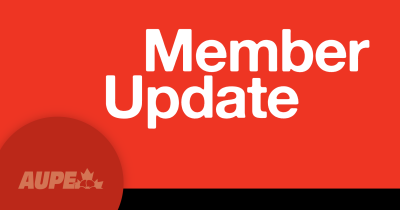OHS MEMBER UPDATE: Important reminder about employer obligations
Now more than ever health and safety legislation must be respected
Apr 06, 2020
Important reminder about employer obligations
Now more than ever health and safety legislation must be respected
Members are reminded that Alberta occupational health and safety (OHS) legislation includes a number of provisions that can apply when respiratory viruses are in the workplace. Some of these are included below.
General duty
- Employers, supervisors and workers have general responsibilities under the OHS Act.
- Employers must ensure, as far as reasonably practicable, the health and safety of workers and others at or around their work site.
- Supervisors must protect, as far as reasonably practicable, the health and safety of workers they supervise.
- Workers must take reasonable care and cooperate with the employer to ensure the health and safety of themselves and others at the work site.
Hazard assessment and control
Employers must perform a hazard assessment to identify existing and potential hazards at a work site. Part 2 of the OHS Code outlines minimum hazard assessment requirements. Eliminate a hazard wherever you can. When elimination is not possible or reasonable, it must be controlled. There is a hierarchy of controls that must be followed.
- First choice: engineering controls. These control a hazard at the source. Depending on the workplace and processes, examples might include ventilation systems or physical barriers, such as plexiglass.
- Second choice: administrative controls. These change the way people work. Examples include worker training or hand hygiene, social distancing, alternate work arrangement or regular workplace cleaning policies.
- Third choice is personal protective equipment (PPE), which controls the hazard at the worker. PPE examples can include gloves, eye protection, facemasks or respirators. In some circumstances, PPE may be required.
Employers must ensure that workers are trained in the PPE they are expected to use, and that PPE is maintained and in good condition to perform the functions for which it was designed.
PPE has to meet OHS Code Part 18 requirements. For instance, respirators must be approved by a standards setting organization acceptable by the Alberta OHS Director of Occupational Hygiene. If a respirator is required and depends on a facial seal to work effectively, the worker must be fit-tested. The worker must be clean-shaven where the respirator seals to the skin of the face.
Employers may need a mix of engineering and administrative controls and PPE to protect workers. Effective controls for workplace hazards depend on site and task-specific factors. For instance, at work sites where workers have a high risk of exposure to infectious droplets and/or airborne hazards – such as health care settings – respirators may be part of the control mix. Other work environments may not require the same type of controls for hazards associated with a respiratory virus.
Employers need to do a risk assessment to determine what controls would be most appropriate at their specific work site.
In all cases, employers must evaluate the effectiveness of their control measures, and review and revise hazard assessments as needed, to prevent the development of unsafe or unhealthy working conditions.
Business continuity
Employers should review and identify operational areas that may be vulnerable to staff absenteeism, if workers are sick or need to stay home to take care of sick family members.
Questions to ask in relation to potential respiratory virus hazards may include:
Who can be exposed to respiratory viruses in the workplace? Think about workers who interact regularly with sick patients, crowds, children, travellers or other members of the public.
What job tasks increase potential exposure to respiratory viruses in the workplace (for example, aerosol generating medical procedures)?
How often are workers potentially exposed?
Employers may need to consider other potential hazards, including:
- stress (for instance from fear of illness, concern for sick family members or changed job roles due to absent co-workers)
- fatigue (for example if workers have to put in extra hours)
- changes in working conditions related to increased or different workloads
Options employers can explore include:
- alternative working arrangements such as telework
- teleconferences or virtual meetings instead of in-person meetings
- using mail, fax, telephone or email communication to help decrease in-person contact with co-workers or customers
If you have any concerns about OHS at your workplace, please complete this form or contact the Member Resource Centre at 1-800-232-7284 to speak to a Resource Centre Agent, who can direct your call accordingly, between the hours of 8:30 a.m. to 4:30 p.m., Monday to Friday.
News Category
- Member update
Sector
- Health care
- Government Services
- Boards/agencies/local government
- Education
Committee
- Occupational health & safety committee
